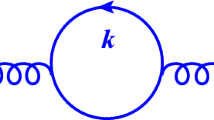Summary
In two papers, of which this is the first, an attempt has been made to link the hadronic geometry of the space-time with the gauge theory of strong interactions. This has been done by postulating a unified hadronic metric tensorf rs(X, y) of strong gravity and strong electromagnetism and showing that the Christoffel symbol arising from this metric tensor is responsible for nine gauge vector fields (A (0)r ,B (α)r ) of gauge groupU 1×SU 3 withU 1 having symmetry-breaking properties.
Riassunto
In due lavori, il primo dei quali è questo, si tenta di mettere in relazione la geometria hadronica dello spazio-tempo con la teoria di gauge delle interazioni forti. Ciò si effettua postulando l'esistenza di un tensore metrico hadronico unificatof rs(X, y) della gravità forte e dell'elettromagnetismo forte e dimostrando che il simbolo di Christoffel derivante da tale tensore metrico dà origine a nove campi vettoriali di gauge (A (0)r ,B (α)r del gruppo di gaugeU 1×SU 3, nel qualeU 1 possiede proprietà che rompono la simmetria.
Резюме
В первой из двух работ на эту тему делается попытка связать адронную геометрию пространства-времени с калибровочной теорией сильных взаимодействий. Это удается сделать, постулируя единый адронный метрический тензорf rs(X, y) для сильной гравитации и сильного электромагнетизма и показывая, что символы Кристоффеля, возникающие из этого метрического тензора являются причиной девяти калибровочных векторных полей (A (0)r ,B (α)r для калибровочной группыU 1×SU 3, причемU 1 обладает свойставми нарушения симметрии.
Similar content being viewed by others
References
J. J. Sakurai:Ann. of Phys.,11, 1 (1966).
Y. Ne'eman:Nucl. Phys.,26, 222 (1961).
S. Heskia:Progr. Theor. Phys.,45, 227 (1971).
S. Heskia:Progr. Theor. Phys.,45, 640 (1971).
H. Yukawa:Phys. Rev.,76, 300, 1731 (1949).
C. J. Isham, A. Salam andJ. Strathdee:Phys. Rev. D,3, 867 (1971).
A. Inomata andD. Peak:Progr. Theor. Phys.,42, 134 (1969).
V. Ne'eman:Phys. Rev.,134, B 297 (1964).
S. Heskia:Nuovo Cimento,5 A, 305 (1971).
J. I. Horvath:Phys. Rev.,80, 901 (1950).
J. I. Horvath:Suppl. Nuovo Cimento,9, 444 (1958).
Y. Takano:Progr. Theor. Phys.,40, 1159 (1968).
Y. Ne'eman:Rev. Mod. Phys.,37, 227 (1965).
K. Yano:Differential geometry on complex and almost complex spaces (International Series of Monographs in Pure and Applied Mathematics, 49).
A. Lichnerowicz:Théorie globale des connexions et des groupes d'holonomie (Rome, 1955).
J. A. Schouten:Ricci Calculus, II ed. (Berlin, 1954), p. 375.
H. G. Loos:Journ. Math. Phys.,8, 2114 (1967).
D. Bedler, R. Dashen andS. Frautschi:Phys. Rev.,136, B 1777 (1964).
Author information
Authors and Affiliations
Additional information
Traduzione a cura della Redazione.
Переведено редакцией.
Rights and permissions
About this article
Cite this article
Heskia, S. Hadronic geometry of space-time and gauge theory of strong interactions.—I. Nuov Cim A 19, 90–102 (1974). https://doi.org/10.1007/BF02785445
Received:
Published:
Issue Date:
DOI: https://doi.org/10.1007/BF02785445



